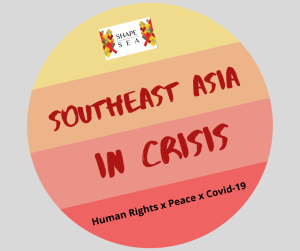Nanda Blestri JasumaUndergraduate student of International Relations inUniversitas Muhammadiyah Yogyakarta
 India has enforced a national lockdown since March 25. The government officially announced that the restrictions included shutting schools, offices, and shops, a prohibition on public transportation and airline travel, as well as shutting the states borders. The announcement caused panic among the citizens as they were psychologically unprepared for a total lockdown. Many people were fearful of lacking essential items, having no savings and of unpredictable calamities that may accompany the pandemic (Singh, Goel, Kumar, & Gettleman, 2020).After nearly three months, India has passed through five phases of lockdown. The latest, lockdown 5.0 is expected to be the starting point of Unlock 1 that allows the opening up of restaurants, malls, and places of worship (Express Web Desk, 2020). Even though school activity and international air travel are still prohibited, the movement of people and goods between states is now permitted.Meanwhile, in Indonesia, the government decided to impose large-scale social restrictions (known by their Indonesian acronym PSBB) rather than a national lockdown as India has done. The policy was announced two weeks after the first day of lockdown in India. President of Indonesia aimed to curb the virus transmission whilst avoiding economic paralysis.The PSBB or LSSR is more like a partial or local lockdown that allows people to keep working and going to classes, although online. Although large gatherings are prohibited, coffee shops and restaurants are still open but with certain restrictions. These measures are aimed to strengthen physical distancing, so that the chain of transmission can be prevented without causing a lot of economic damage.Like India, the Indonesia government has decided to adopt a ˜new normal era of transition policies. Some relaxations include reopening malls, business districts, offices, airports, and easing international as well as domestic travels. However, under the transition appropriate protocols are to remain in place.As highly populated countries, both India and Indonesia have implemented such measures to protect their many millions of citizens. Nevertheless, the efforts taken by them have yet to show many positive outcomes. Both countries probably did not properly-prepare their issued policies.India was already experiencing a shortage of medical apparel and available healthcare facilities at the time when the first lockdown was announced. Further, there was a late response from the government regarding the financial aids package, which was only announced two days after the lockdown began. Moreover, the aid package was effectively worthless compared to peoples expenses during the pandemic (Chahal, 2020). Indonesia also experienced problems. As the response to the pandemic was similarly unprepared. The PSBB was expected to be fine-tuned by the local district heads; but it was not implemented effectively as many regulations overlapped with PSBB. For instance, many manufacturers were still operating because they followed the regulations of the Ministry of Industry (Khatimah, 2020). This event contributed to peoples confusion given the contradictory regulations.What makes these countries more alike is that the number of cases keep rising, particularly after the relaxation of lockdowns. As of June 16, Indonesian cases have increased to 40.400 from 27.549 two weeks earlier, when the Indonesian government claimed that Indonesia was ready to begin the transition phase. Indonesia thus became the country with the highest number of COVID-19 cases in Southeast Asia.On the other hand, India has overtaken the UKs position as the 4th worst-hit country in the world. India is now facing inevitable failure since it now has more than 350.000 cases and the numbers keep rising. Compared to other countries like Spain, Germany, and the UK, which successfully contained the number of cases by imposing lockdowns, India looks left behind.Being highly populated countries, COVID-19 is more challenging. Better countermeasures should have been imposed from the start so that both countries would have been better able to ˜protect the lives instead of only ˜delaying the deaths. If India and Indonesia push harder, both may get a second chance because the pandemic and its worst impacts are still evolving.References:Chahal, G. (2020, March 27). Coronavirus lockdown: But what is India missing? Retrieved June 20, 2020, from CNBC TV18: https://www.cnbctv18.com/views/coronavirus-lockdown-but-what-is-india-missing-5566591.htmExpress Web Desk. (2020, June 8). Unlock 1.0: What changes for you in malls, religious places from today. Retrieved June 20, 2020, from The Indian Express: https://indianexpress.com/article/india/unlock-1-0-coronavirus-guidelines-malls-religious-places-6447443/Khatimah, H. (2020, April 27). Aturan Hukum Kontradiktif, PSBB di Bodebek Dinilai Tidak Efektif. Retrieved June 20, 2020, from Ayo Bogor: https://m.ayobogor.com/read/2020/04/27/6815/aturan-hukum-kontradiktif-psbb-di-bodebek-dinilai-tidak-efektifSingh, K. D., Goel, V., Kumar, H., & Gettleman, J. (2020, March 25). India, Day 1: Worlds Largest Coronavirus Lockdown Begins. Retrieved June 20, 2020, from The New York Times: https://www.nytimes.com/2020/03/25/world/asia/india-lockdown-coronavirus.html
India has enforced a national lockdown since March 25. The government officially announced that the restrictions included shutting schools, offices, and shops, a prohibition on public transportation and airline travel, as well as shutting the states borders. The announcement caused panic among the citizens as they were psychologically unprepared for a total lockdown. Many people were fearful of lacking essential items, having no savings and of unpredictable calamities that may accompany the pandemic (Singh, Goel, Kumar, & Gettleman, 2020).After nearly three months, India has passed through five phases of lockdown. The latest, lockdown 5.0 is expected to be the starting point of Unlock 1 that allows the opening up of restaurants, malls, and places of worship (Express Web Desk, 2020). Even though school activity and international air travel are still prohibited, the movement of people and goods between states is now permitted.Meanwhile, in Indonesia, the government decided to impose large-scale social restrictions (known by their Indonesian acronym PSBB) rather than a national lockdown as India has done. The policy was announced two weeks after the first day of lockdown in India. President of Indonesia aimed to curb the virus transmission whilst avoiding economic paralysis.The PSBB or LSSR is more like a partial or local lockdown that allows people to keep working and going to classes, although online. Although large gatherings are prohibited, coffee shops and restaurants are still open but with certain restrictions. These measures are aimed to strengthen physical distancing, so that the chain of transmission can be prevented without causing a lot of economic damage.Like India, the Indonesia government has decided to adopt a ˜new normal era of transition policies. Some relaxations include reopening malls, business districts, offices, airports, and easing international as well as domestic travels. However, under the transition appropriate protocols are to remain in place.As highly populated countries, both India and Indonesia have implemented such measures to protect their many millions of citizens. Nevertheless, the efforts taken by them have yet to show many positive outcomes. Both countries probably did not properly-prepare their issued policies.India was already experiencing a shortage of medical apparel and available healthcare facilities at the time when the first lockdown was announced. Further, there was a late response from the government regarding the financial aids package, which was only announced two days after the lockdown began. Moreover, the aid package was effectively worthless compared to peoples expenses during the pandemic (Chahal, 2020). Indonesia also experienced problems. As the response to the pandemic was similarly unprepared. The PSBB was expected to be fine-tuned by the local district heads; but it was not implemented effectively as many regulations overlapped with PSBB. For instance, many manufacturers were still operating because they followed the regulations of the Ministry of Industry (Khatimah, 2020). This event contributed to peoples confusion given the contradictory regulations.What makes these countries more alike is that the number of cases keep rising, particularly after the relaxation of lockdowns. As of June 16, Indonesian cases have increased to 40.400 from 27.549 two weeks earlier, when the Indonesian government claimed that Indonesia was ready to begin the transition phase. Indonesia thus became the country with the highest number of COVID-19 cases in Southeast Asia.On the other hand, India has overtaken the UKs position as the 4th worst-hit country in the world. India is now facing inevitable failure since it now has more than 350.000 cases and the numbers keep rising. Compared to other countries like Spain, Germany, and the UK, which successfully contained the number of cases by imposing lockdowns, India looks left behind.Being highly populated countries, COVID-19 is more challenging. Better countermeasures should have been imposed from the start so that both countries would have been better able to ˜protect the lives instead of only ˜delaying the deaths. If India and Indonesia push harder, both may get a second chance because the pandemic and its worst impacts are still evolving.References:Chahal, G. (2020, March 27). Coronavirus lockdown: But what is India missing? Retrieved June 20, 2020, from CNBC TV18: https://www.cnbctv18.com/views/coronavirus-lockdown-but-what-is-india-missing-5566591.htmExpress Web Desk. (2020, June 8). Unlock 1.0: What changes for you in malls, religious places from today. Retrieved June 20, 2020, from The Indian Express: https://indianexpress.com/article/india/unlock-1-0-coronavirus-guidelines-malls-religious-places-6447443/Khatimah, H. (2020, April 27). Aturan Hukum Kontradiktif, PSBB di Bodebek Dinilai Tidak Efektif. Retrieved June 20, 2020, from Ayo Bogor: https://m.ayobogor.com/read/2020/04/27/6815/aturan-hukum-kontradiktif-psbb-di-bodebek-dinilai-tidak-efektifSingh, K. D., Goel, V., Kumar, H., & Gettleman, J. (2020, March 25). India, Day 1: Worlds Largest Coronavirus Lockdown Begins. Retrieved June 20, 2020, from The New York Times: https://www.nytimes.com/2020/03/25/world/asia/india-lockdown-coronavirus.html





